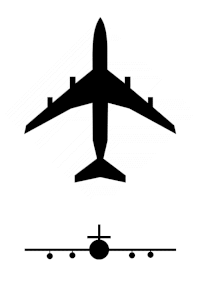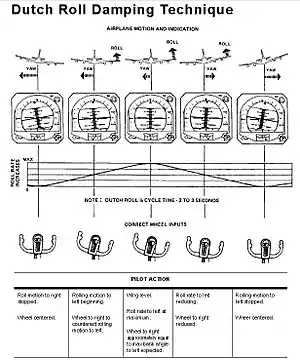

Dutch roll is a type of aircraft motion consisting of an out-of-phase combination of "tail-wagging" (yaw) and rocking from side to side (roll). This yaw-roll coupling is one of the basic flight dynamic modes (others include phugoid, short period, and spiral divergence). This motion is normally well damped in most light aircraft, though some aircraft with well-damped Dutch roll modes can experience a degradation in damping as airspeed decreases and altitude increases. Dutch roll stability can be artificially increased by the installation of a yaw damper. Wings placed well above the center of gravity, sweepback (swept wings) and dihedral wings tend to increase the roll restoring force, and therefore increase the Dutch roll tendencies; this is why high-winged aircraft often are slightly anhedral, and transport-category swept-wing aircraft are equipped with yaw dampers. A similar phenomenon can happen in a trailer pulled by a car.
Stability
In aircraft design, Dutch roll results from relatively weaker positive directional stability as opposed to positive lateral stability. When an aircraft rolls around the longitudinal axis, a sideslip is introduced into the relative wind in the direction of the rolling motion (due to the lateral component of lift when the wings are not level). Strong lateral stability (due to the more-direct airflow past the down wing, which has been pivoted forward by the slip) begins to restore the aircraft to level flight. At the same time, somewhat weaker directional stability (due both to greater drag from the wing which is now generating greater lift, and by aerodynamic force on the vertical fin due to the yaw) attempts to correct the sideslip by aligning the aircraft with the perceived relative wind. Since directional stability is weaker than lateral stability for the particular aircraft, the restoring yaw motion lags significantly behind the restoring roll motion. The aircraft passes through level flight as the yawing motion is continuing in the direction of the original roll. At that point, the sideslip is introduced in the opposite direction and the process is reversed.
There is a trade-off between directional and lateral stability. Greater lateral stability leads to greater spiral stability and lower oscillatory stability. Greater directional stability leads to spiral instability but greater oscillatory stability.[1]
Mechanism
The most common mechanism of Dutch roll occurrence is a yawing motion which can be caused by any number of factors. As a swept-wing aircraft yaws (to the right, for instance), the left wing becomes less-swept than the right wing in reference to the relative wind. Because of this, the left wing develops more lift than the right wing causing the aircraft to roll to the right. This motion continues until the yaw angle of the aircraft reaches the point where the vertical stabilizer effectively becomes a wind vane and reverses the yawing motion. As the aircraft yaws back to the left, the right wing then becomes less swept than the left resulting in the right wing developing more lift than the left. The aircraft then rolls to the left as the yaw angle again reaches the point where the aircraft wind-vanes back the other direction and the whole process repeats itself. The average duration of a Dutch roll half-cycle is 2 to 3 seconds.
The Dutch roll mode can be excited by any use of aileron or rudder, but for flight test purposes it is usually excited with a rudder singlet (a short sharp motion of the rudder to a specified angle, and then back to the centered position) or doublet (a pair of such motions in opposite directions). Some larger aircraft are better excited with aileron inputs. Periods can range from a few seconds for light aircraft to a minute or more for airliners.
Tex Johnston describes the Dutch roll as, "...an inherent characteristic of swept-wing aircraft. It starts with a yaw. In a 35-degree swept-wing airplane, a yaw is accompanied by a simultaneous roll in the direction of yaw. The roll is caused by changing lift factors as the airflow path over the wing changes. For example, in a left yaw the left wing slews toward the rear so that airflow is displaced spanwise from its normal front-to-rear path over the airfoil section. That reduces lift. Simultaneously, the advancing right wing gets more chordwise flow, and so its lift is increased. In combination the two conditions create a left roll. Similarly, a yaw to the right results in a roll to the right. An oscillation is set up."[2]
Rolling on a heading
Dutch roll is also the name (considered by professionals to be a misnomer) given to a coordination maneuver generally taught to student pilots to improve their "stick-and-rudder" technique. The aircraft is alternately rolled as much as 60 degrees left and right while rudder is applied to keep the nose of the aircraft pointed at a fixed point. More correctly, this is a rudder coordination practice exercise, to teach a student pilot how to correct for the effect known as adverse aileron yaw during roll inputs.
This coordination technique is better referred to as "rolling on a heading", wherein the aircraft is rolled in such a way as to maintain an accurate heading without the nose moving from side-to-side (or yawing). The yaw motion is induced through the use of ailerons alone due to aileron drag, wherein the lifting wing (aileron down) is doing more work than the descending wing (aileron up) and therefore creates more drag, forcing the lifting wing back, yawing the aircraft toward it. This yawing effect produced by rolling motion is known as adverse yaw. This has to be countered precisely by application of rudder in the same direction as the aileron control (left stick, left rudder – right stick, right rudder). This is known as synchronised controls when done properly, and is difficult to learn and apply well. The correct amount of rudder to apply with aileron is different for each aircraft.
Name
The origin of the name Dutch roll is uncertain. However, it is likely that this term, describing a lateral asymmetric motion of an airplane, was borrowed from a reference to similar-appearing motion in ice skating. In 1916, aeronautical engineer Jerome C. Hunsaker published: "Dutch roll – the third element in the [lateral] motion [of an airplane] is a yawing to the right and left, combined with rolling. The motion is oscillatory of period for 7 to 12 seconds, which may or may not be damped. The analogy to 'Dutch Roll' or 'Outer Edge' in ice skating is obvious."[3] In 1916, Dutch Roll was the term used for skating repetitively to right and left (by analogy to the motion described for the aircraft) on the outer edge of one's skates. By 1916, the term had been imported from skating to aeronautical engineering, perhaps by Hunsaker himself. 1916 was only five years after G. H. Bryan did the first mathematical analysis of lateral motion of aircraft in 1911.[4]
Accidents
- On October 19, 1959, a Boeing 707 on customer-acceptance flight, where the yaw damper was turned off to familiarize the new pilots with flying techniques, a trainee pilot's actions violently exacerbated the Dutch roll motion and caused three of the aircraft’s four engines to be torn from its wings. The plane, a brand new 707-227, N7071, destined for Braniff, crash-landed on a river bed north of Seattle at Arlington, Washington, killing four of the eight occupants.[5][6]
- On August 12, 1985, Japan Airlines Flight 123, a Boeing 747SR, exhibited a Dutch roll in combination with phugoid cycles after losing all hydraulics following the loss of its vertical stabiliser due to an improperly-repaired rear pressure bulkhead rupturing from metal fatigue. It would ultimately crash in the deadliest single-aircraft accident in history.
- On March 6, 2005, Air Transat Flight 961, an Airbus A310, was involved in a Dutch roll incident following structural failure of the rudder at cruising altitude after departure from Juan Gualberto Gomez Airport, Varadero, Cuba. The aircraft returned to the airport with serious structural damage and one flight attendant slightly injured.
- On May 3, 2013, a McConnell AFB, KS (USAF) KC-135R, 63-8877, flown by a Fairchild AFB, Washington aircrew, broke up in flight about eleven minutes after taking off from Manas Air base in Kyrgyzstan, killing all three crew members.[7][8] It was determined that a rudder power control unit malfunction led to a Dutch roll oscillatory instability. Not recognizing the Dutch roll, the crew used the rudder to stay on course, which exacerbated the instability, leading to an unrecoverable flight condition. The over-stressed tail section detached and the rest of the aircraft broke apart soon after. The aircraft was at cruise altitude about 200 km west of Bishkek before it crashed in a mountainous area near the village of Chorgolu, close to the border between Kyrgyzstan and Kazakhstan.[9][10][11][12]
- On October 30, 2015 a Leonardo-Finmeccanica-Helicopters Division (formerly AgustaWestland) AW609 prototype crashed in Italy killing its two pilots. The Italian ANSV established that Dutch roll during a high-speed test was the probable cause.[13][14]
See also
References
- ↑ Davies, David P. (1971). Handling the Big Jets: An Explanation of the Significant Differences in Flying Qualities Between Jet Transport Aeroplanes and Piston Engined Transport Aeroplanes, Together with Some Other Aspects of Jet Transport Handling (3rd ed.). Air Registration Board. p. 100. ISBN 9780903083010.
- ↑ Johnston, A.M. "Tex" (1992). Tex Johnston: Jet-Age Test Pilot. New York: Bantam. p. 140. ISBN 9780553295870.
- ↑ Hunsaker, Jerome C. (1916). "Dynamical Stability of Aeroplanes". Proceedings of the National Academy of Sciences of the United States of America. National Academy of Sciences. 2 (5): 282. Bibcode:1916PNAS....2..278H. doi:10.1073/pnas.2.5.278. PMC 1091005. PMID 16576144.
- ↑ Bryan, G. H. (1911). Stability in Aviation. p. 123.
- ↑ Accident description at the Aviation Safety Network
- ↑ HistoryLink, posted 7/23/2017. Boeing 707 jetliner crashes in Snohomish County, October 19, 1959. Archived 31 October 2020 at the Wayback Machine
- ↑ Accident description for 63-8877 at the Aviation Safety Network. Retrieved on 21 October 2014.
- ↑ Humphrey, Jeff (20 June 2013). "Cellphone video may have captured deadly KC-135 crash". Spokane, Washington. Archived from the original on 15 March 2016. Retrieved 21 October 2014.
- ↑ "Investigation board determines cause of KC-135 crash in May". 14 March 2014. Archived from the original on 16 March 2017. Retrieved 21 October 2014.
- ↑ Davis, Kristin (13 March 2014). "Malfunction, pilot error caused May KC-135 crash". Air Force Times. Springfield, Virginia. Retrieved 21 October 2014.
- ↑ Camden, Jim (13 March 2014). "Tanker's tail separated in flight before Kyrgyzstan crash". Spokesman-Review. Spokane, Washington. Archived from the original on 28 January 2021. Retrieved 21 October 2014.
- ↑ U.S. Air Force Aircraft Accident Investigation Board Report; KC-135R, T/N 63-8877; 22nd Air Refueling Wing McConnell AFB, Kansas; Location: 6 miles S. of Chaldovar, Kyrgyz Republic (PDF) (Report). 31 December 2013. Archived (PDF) from the original on 21 October 2014. Retrieved 21 October 2014.
- ↑ Johnson, Oliver. "AgustaWestland: AW609 was performing high-speed tests on day of crash". Archived from the original on 19 November 2021. Retrieved 28 December 2019.
- ↑ Interim Report Archived 19 November 2021 at the Wayback Machine ANSV
External links
Articles
- How to Halt Dutch Roll from FltPlan at the Wayback Machine (archived 2015-07-22)
- What Is Dutch Roll, And How Do You Prevent It?
Videos
- This is not how planes fly at the Wayback Machine (archived 2020-05-07) A Dutch roll during a test flight of a Tupolev airliner. Anecdotal information points to yaw damper malfunction as the cause. Aircraft landed safely.
- Dutch Roll animation
- Autoflight #12 Yaw Damper